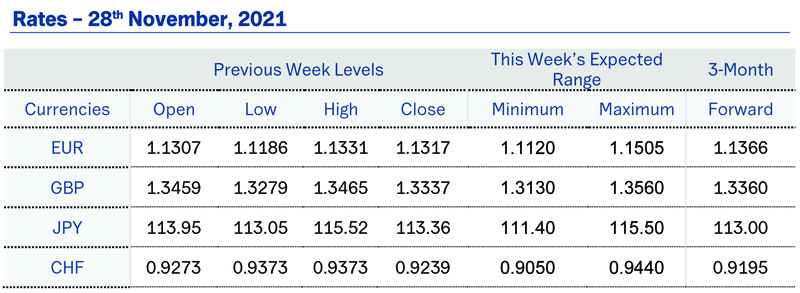KUWAIT: The Federal Reserve released the minutes of their meeting from earlier this month expressing their concern about inflation. Fed officials said they would be willing to raise interest rates if inflation keeps on rising. The minutes also signaled that the Fed could be reducing their stimulus for the pandemic relief. "Various participants noted that the committee should be prepared to adjust the pace of asset purchases and raise the target range for the federal funds rate sooner than participants currently anticipated if inflation continued to run higher than levels consistent with the committee's objectives," the minutes stated. The central bank will be reducing its monthly purchased by $15 billion of which $10 billion in treasuries and $5 billion in mortgage backed securities.
Some members also wanted a faster pace to raise interest rates. The Fed Funds Futures was pricing in 3 rate hikes for 2022 following the release of the minutes on Wednesday. However, fears spurred in global markets and risk off mode was the sentiment on Friday after a new COVID variant was identified in South Africa. Worries of outbreaks and further disruptions worries markets and a selloff in global markets was the theme on Friday. Probabilities for interest rate hikes in the US fell and currently only 2 rate hikes are priced in for 2022.
The risk off mode sent the 10-year US treasury yield tumbling by 16 basis points from 1.63% to 1.47% in one day. As for safe-haven currencies, both the Japanese yen and Swiss franc reversed their trend and gained up to 1.51% in one day. As for the greenback, although the dollar index was gaining momentum throughout last week, the dollar retreated and fell below 96.500 level to close the week at 96.089.
Business activity slows
Amid labor shortages and raw materials delays, US business activity slowed moderately in November. Growth softened as service providers and manufacturers continue to struggle with higher inflation and an uncertain path to recovery. The IHS Markit flash composite purchasing managers' index slipped to 56.5 in November from 57.6 a month prior. Digging into the report, the gauge of manufacturing activity improved while services growth eased. The flash services PMI rose to 59.1 in November from 58.4 a month earlier, aided by stronger output and orders. Meanwhile, manufacturing activity slipped to 57 from 58.7 in October.
EU & UK
Eurozone economic growth accelerates
The flash reading for the Eurozone composite output index increased to 55.8 in November from 54.2 in October, marking a two-month high according to data released by HIS Markit last week. "A stronger expansion of business activity in November defied economists' expectations of a slowdown, but is unlikely to prevent the Eurozone from suffering slower growth in the fourth quarter, especially as rising virus cases look set to cause renewed disruptions to the economy in December," IHS Markit's chief business economist Chris Williamson said.
Looking at the data by sector, services outperformed manufacturing for a third straight month. Both far above the 50-expansion mark, Europe's manufacturing PMI came in at 58.6 while services registered at 56.6. The survey took place between November 10 and 19, likely not capturing the full effect of coronavirus restrictions recently imposed in some countries. On the FX front, the single currency kept shedding value and broke the 1.12 level reaching a low of 1.1186 on Thursday. However, the news about the new variant and the volatility caused in FX markets pushed the EUR to a high of 1.1331.
New Zealand
RBNZ lifts interest rates for second time
In its final policy meeting of the year, the Reserve Bank of New Zealand raised the official cash rate by 25 basis points to 0.75% as widely expected. Today, forecasters are expecting borrowing costs to rise to at least 2% by next year and possibly higher. Driven by rising inflationary pressures and easing coronavirus restrictions, the decision came after annual inflation hit 4.9% in Q3 and the jobless rate fell to 3.4%. Meanwhile, house prices have doubled over the past seven years and are currently the most unaffordable among OECD nations. The country is set to end lockdowns starting December 3rd, allowing all business to resume operations.
Commodities
Emergency oil reserves
Last week, President Joe Biden announced the release of emergency oil reserves to combat higher energy prices. The Department of Energy declared it would release 50 million barrels of oil from the Strategic Petroleum Reserve, the largest release from the reserve in US history. Meanwhile other nations such as the UK, India, Japan, Korea and China were said to be releasing about 11 million barrels in total.
The coordinated effort to reduce prices follows a decision by OPEC+ to ignore calls to accelerate supply. However, the plan fell short of expectations and prices rose instead. Attention will now shift to how OPEC and its allies response. Crude prices tumbled on Friday as the new COVID variant spooked markets and worries of potential supply chain disruptions and demand caused the black gold prices to drop by more than 10% on Friday.











